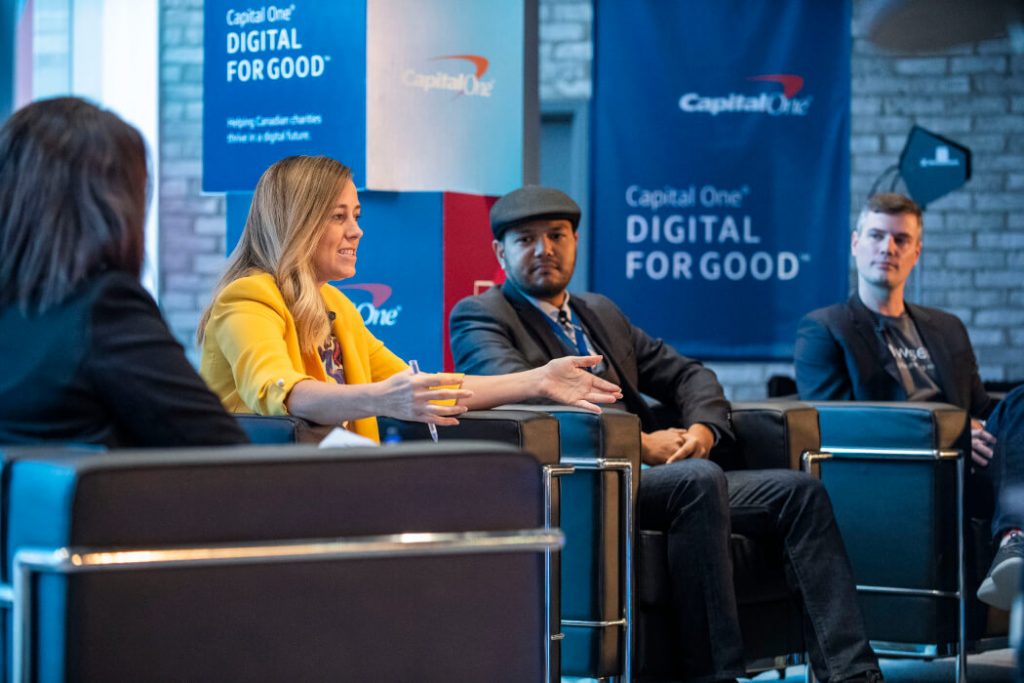Most people view charities as grassroots action. They think of charities on the front lines, providing shelter, food, clothing, or other resources to the elderly, children, or animals. What isn’t often considered is how these activities get accomplished.
Canadian charities and nonprofits coordinate hundreds, if not thousands of volunteers, usually on a limited budget with small staff. In order to achieve their missions in the 21st century, charities need to modernize, leveraging modern technology to scale. Unfortunately, the majority of charity leaders feel they are falling behind on that goal.
Capital One’s recent Digital for Good events, comprising a Tech Jam to build solutions for charities combined with a Summit to provide learning and networking opportunities, hopes to help charities catch up. Throughout the Tech Jam, local tech leaders came together to help solve charities’ tech-oriented problems. For charities just getting started, or in search of the right questions to ask, the Summit provided a clear message: start small or start big, but you need to start. In particular, speakers focused on the difference between two seemingly similar terms, “digital strategy” versus “digital transformation.”
Strategy versus transformation
Entrepreneur and tech media personality Amber Mac gave the opening remarks at the Summit, noting that we are in an era of rapid technological change. To keep up, she told the audience that leaders must enter a phase of “relentless adaption” and continuous learning.
In many charities, the first step towards change is through digital strategy. Mac said that 66 percent of Canadian charities believe their social mission is held back or at risk because they can’t access the right technologies, and 67 percent believe their fundraising is at risk, but charity leaders don’t feel they are prepared for the change. A digital strategy is meant to bridge that gap, offering a plan of attack for charity leaders to build stronger organizations.
Unfortunately, as Mac and the other speakers explained, ‘digital strategy’ is only a one-time affair. It’s based on the idea that you can use new technologies on existing structures, something that Marina Glogovac, CEO of CanadaHelps, said is a temporary measure at best.
“At some point, technology will demand new behaviours,” said Glogovac. “You can’t expect that new tech will just be bolted onto the old organization.”
The ability to constantly adapt to the new behaviours that technology demands is called digital transformation. Where digital strategy uses technology as a point solution or within a silo, digital transformation redesigns your entire organization to integrate digital tools and processes throughout. For Glogovac, this includes HR strategy, technology resources, content strategy, marketing and channel development, and data plans.
“These times call for different types of leadership skills,” said Glogovac. “Not necessarily different leaders, but different skills.”

The key is culture
For charities with limited resources, the demands of digital transformation can seem daunting. Leaders not only face challenges knowing what technology to use but also, frankly, don’t have time. They have volunteer forces to support, staff to lead, and fundraising to do in support of their mission. This leaves charity leaders caught in a situation where the future of their organization requires their investment in digital transformation while the present is taking up all their time — a scary proposition given that funding for tech solutions often comes from charities’ highly scrutinized administrative budgets.
“We know that 70 percent of digital transformation efforts fail. Often, it’s not because of tech. It’s because of culture.”
– Marina Glogovac
During the Summit’s fireside chat on technology in the nonprofit sector, Wisely CTO Ryan Henry said that the first step any charity leader should take with tech is to find tools that save them time.
“You don’t exist to run your day-to-day operations,” said Henry. “You exist to achieve your mission. You should be minimizing the time, effort, and money you spend on your day-to-day so you can focus on your mission. That’s what the technology is there to support.”
This shift – from using tech ad-hoc to leveraging small pieces of technology as the first step on a much longer journey toward transformation – will provide the time needed to think about and take action on much larger items.
Once charity leaders start the process of letting technology take on some of the manual heavy lifting, they can begin to focus on the real reasons that digital transformation efforts fail: culture.
“We know that 70 percent of digital transformation efforts fail,” said Glogovac. “Often, it’s not because of tech. It’s because of culture.”
Glogovac explained many of the core reasons digital transformation efforts fail, noting it’s rarely because of tech. Instead of viewing technology as a one-time thing, Glogovac encouraged leaders to see it as a journey that is ongoing and iterative, not once and done. This is true not just because technology is improving at a rapid pace, but also because new technologies are always being developed.
Glogovac also cautioned the audience to be aware of the humanity of the situation. Often, she said, employees fear that implementing technology will displace them. The fear of losing your job can be so great that it drives some employees to sabotage efforts and strongly resist any change.
Despite having challenges with technology, though, Glogovac challenged charity leaders to overcome their own fear and step up to the plate to demonstrate how technology can be used in the best way possible.
“We have the responsibility to use new technologies responsibly and model for others what that is,” said Glogovac. “It’s about asking the right questions and looking at the right things.”
BetaKit is a Digital for Good media partner and this article is sponsored by Capital One.


